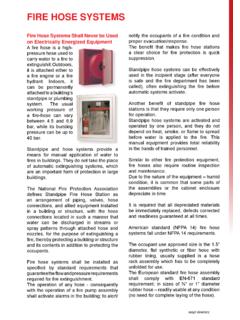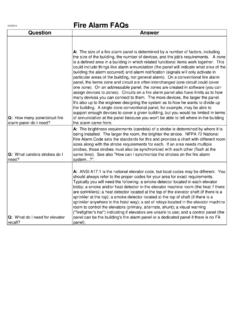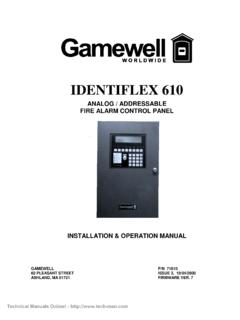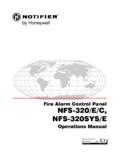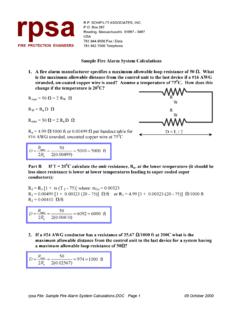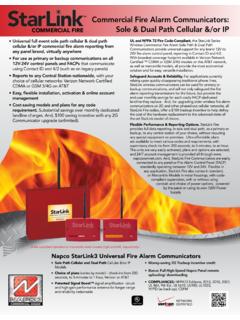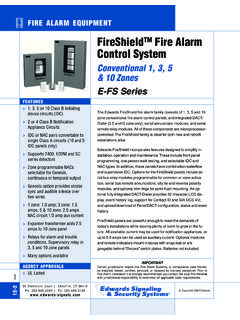Transcription of Fire Alarm System
1 Ssspl directoryAn automatic fire Alarm System is designed to detect the presence of fire by monitoring environmental changes associated with combustion. fire Alarm systems are used to notify people to evacuate in the event of a fire or other emergency, to request such civil defense as fire brigades emergency services, and to send digital signals to associate systems interface to control the spread of fire and Alarm Systems are classified as either Conventional or Analogue systems are so called because they are the older type of fire Alarm systems. The detector communicates with the fire Alarm control panel simply by changing state from high impedance to low impedance when smoke is detected. Smoke detectors are typically wired together up to 32 detectors on each zone and a single fire Alarm control panel can usually monitor a number of zones which can be arranged to correspond to different areas of a building. In the event of a fire , the fire Alarm control panel is able to identify which zone contains the detector or detectors in Alarm , but it s not able to identify which individual detector or detectors is in an Alarm Alarm System *The American standard for installations of fire Alarm System follows NFPA72, whereas the European standard follows EN-54 Analog AddressableThis type of installation gives each detector on a System an individual number, or address.
2 Thus, analog addressable detectors allow a fire Alarm control panel, and therefore fire fighters, to know the exact location of an Alarm . In certain systems, a graphical representation of the building is provided and the exact location of the Alarm can indicated on the diagram. Analog addressable systems are usually more expensive than conventional non-addressable systems, and offer extra options, such as a custom level of sensitivity (sometimes called Day/Night mode) and contamination detection from the main panel that allows determination of a wide range of faults. Panels can also be interconnected to control a very large number of detectors in many other buildings commonly used in hospitals, universities, resorts and similar large ComponentSFire Alarm control panel (FACP): This component is the central hub of the System and monitors inputs, System integrity, controls outputs and relays Power supply: Commonly the non-ssspl directoryswitched 120 or 240 Volt Alternating Current source supplied from a commercial power utility.
3 In non-residential applications, a branch circuit is dedicated to the fire Alarm System and its constituents. Dedicated branch circuits should not be confused with Individual branch circuits which supply energy to a single (backup) Power supplies: This component, commonly consisting of sealed lead-acid storage batteries or other emergency sources including UPS, is used to supply energy in the event of a primary power Devices: This component acts as an input to the fire Alarm control unit and is either manually or automatically appliances: This component uses energy supplied from the fire Alarm System or other stored energy source, to inform the proximate persons of the need to take action, usually to Safety Interfaces: This interface allows the fire Alarm System to control aspects of the built environment and to prepare the building for fire and to control the spread of smoke fumes and fire by influencing air movement, lighting, process control, human transport and devICeSManually actuated devices.
4 Break glass stations, Buttons and manual pull station are constructed to be readily located (near the exits), identified, and actuated devices can take many forms intended to respond to any number of detectable physical changes associated with fire . A wide range of detectors exist using varying mechanism to detect the presence of fire , detecting the presence of smoke, convected thermal energy, radiant energy or excess levels of gas. Each type has its own benefits and installation requirements. The most commonly used detectors include Smoke Detectors and Heat Detectors. Other specialised detectors include Beam, Flame, Duct, Cable and many ApplIAnCeSAudible, visible & textual to alert the occupants. Audible or visible signals are the most common and may utilize speakers to deliver live or pre-recorded instructions to the textual appliances, which are employed as part of a fire Alarm System that includes Emergency Voice Alarm Communications (EVAC) capabilities.
5 High reliability speakers are used to notify the occupants of the need for action in connection with a fire or other emergency. These speakers are employed in large facilities where general undirected evacuation is considered impracticable or undesirable. The signals from the speakers are used to direct the occupant s response. The System may be controlled from one or more locations within the building known as fire Wardens Stations, or from a single location designated as the building fire Command Center. ssspl directorySpeakers are automatically actuated by the fire Alarm System in a fire event, and following a pre-alert tone, selected groups of speakers may transmit one or more prerecorded messages directing the occupants to safety. Trained personnel activating and speaking into a dedicated microphone can suppress the replay of automated messages in order to initiate or relay time voice SAFety InterFACeMagnetic Smoke Door Holders: Wall or floor mounted solenoids or electromagnets controlled by a fire Alarm System or detection component that magnetically secures spring-loaded self-closing smoke tight doors in the open position.
6 Designed to de-magnetize to allow automatic closure of the door on command from the fire control or upon failure of power source, interconnection or controlling element. Stored energy in the form of a spring or gravity can then close the door to restrict the passage of smoke from one space to another in an effort to maintain a tenable atmosphere on either side of the door during evacuation and fire fighting Mounted Smoke Detection: Smoke detection mounted in such a manner as to sample the airflow through duct work and other plenums specifically fabricated for the transport of environmental air into conditioned spaces. Interconnection to the fan motor control circuits are intended to stop air movement, close dampers and generally prevent the recirculation of toxic smoke and fumes produced by fire into occupied ACtuAted InItIAtIng devICeSSmoke detectorA smoke detector is a device that detects smoke, typically as an indicator of fire .
7 Commercial, industrial, and mass residential devices issue a signal to a fire Alarm System , while household detectors, known as smoke alarms, generally issue a local audible and/ or visual Alarm from the detector (photoelectric) -An optical detector is a light sensor. When used as a smoke detector, it includes a light source (incandescent bulb or infrared LED), a lens to collimate the light into a beam, and a photo diode or other photoelectric sensor at an angle to the beam as a light detector. In the absence of smoke, the light passes in front of the detector in a straight line. When smoke enters the optical chamber across the path of the light beam, some light is scattered by the smoke particles, directing it at the sensor and thus triggering the seen in large rooms, such as a gymnasium or an auditorium, are devices to detect a projected beam. A unit on the wall ssspl directorysends out a beam, which is either received by a receiver or reflected back via a mirror.
8 When the beam is less visible to the eye of the sensor, it sends an Alarm signal to the fire Alarm control panel. Optical smoke detectors are quick in detecting particulate (smoke) generated by smoldering (cool, smoky) fires. Many independent tests indicate that optical smoke detectors typically detect particulates (smoke) from hot, flaming fires approximately 30 seconds later than ionization smoke alarms. They are less sensitive to false alarms from steam or cooking fumes generated in kitchen or steam from the bathroom than are ionization smoke alarms. For the aforementioned reason, they are often referred to as toast proof smoke -This type of detector is cheaper than the optical detector; however, it is sometimes rejected because it is more prone to false (nuisance) alarms than photoelectric smoke detectors. It can detect particles of smoke that are too small to be visible. It includes about 37 kBq or 1 Ci of radioactive americium-241 (241Am), corresponding to about g of the isotope.
9 The radiation passes through an ionization chamber, an air-filled space between two electrodes, and permits a small, constant current between the electrodes. Any smoke that enters the chamber absorbs the alpha particles, which reduces the ionization and interrupts this current, setting off the Alarm . European new regulation do not allows any new production of ionization detector due to the radioactive material usedAir-sampling -An air-sampling smoke detector is capable of detecting microscopic particles of smoke. Most air-sampling detectors are aspirating smoke detectors, which work by actively drawing air through a network of small-bore pipes laid out above or below a ceiling in parallel runs covering a protected area. Small holes drilled into each pipe form a matrix of holes (sampling points), providing an even distribution across the pipe network. Air samples are drawn past a sensitive optical device, often a solid-state laser, tuned to detect the extremely small particles of combustion.
10 Air-sampling detectors may be used to trigger an automatic fire response, such as a gaseous fire suppression System , in high-value or mission-critical areas, such as archives or computer server air-sampling smoke detection systems are capable of a higher sensitivity than spot type smoke detectors and provide multiple levels of Alarm threshold, such as Alert, Action, fire 1 and fire 2. Thresholds may be set at levels across a wide range of smoke levels. This provides earlier notification of a developing fire than spot type smoke detection, allowing manual intervention or activation of automatic suppression systems before a fire has developed beyond the smoldering stage, thereby increasing the time available for evacuation and minimizing fire monoxide -and carbon Dioxide DetectionSome smoke alarms use a carbon dioxide sensor or carbon monoxide sensor in order ssspl directoryto detect extremely dangerous products of combustion.

